
In the global furniture trade, your wooden pieces aren’t just products—they’re investments in craftsmanship, culture, and customer trust. But if you’ve ever shipped a high-end oak dining table to Southeast Asia or a walnut sideboard to Germany, you know humidity can turn a premium item into a liability fast.
Did you know? Wood expands and contracts with humidity changes—up to 4% in extreme conditions. That means even a 5% rise in relative humidity (RH) during transit or storage can cause warping, cracking, or glue failure in glued joints. In humid climates like Singapore or Miami, RH often exceeds 70% for over 6 months a year—leading to up to 30% higher return rates due to moisture damage, according to a 2023 report by the International Wood Trade Association.
| Wood Type | Ideal RH Range (%) | Risk at >70% RH |
|---|---|---|
| Solid Oak / Walnut | 40–55% | Warping, mold growth, finish blistering |
| MDF / Plywood | 35–50% | Delamination, swelling, poor adhesion of coatings |
You don’t need a heavy industrial unit for every shipment. For small warehouses or display rooms, a desiccant dehumidifier (like those from Danby or Honeywell) maintains RH between 40–55%, especially effective below 60°F/15°C. For large containers or long-term storage, consider refrigerant-based models that remove 10–15 liters of water per day—ideal for tropical ports where humidity spikes daily.
Use microfiber cloths dampened with pH-neutral wood cleaner (e.g., Bona or Howard’s). Avoid ammonia-based cleaners—they strip protective finishes. Wipe in the direction of grain. Every month, apply a thin coat of beeswax polish to seal pores and reduce moisture absorption by up to 25% (per studies from the Forest Products Laboratory).
For minor surface scratches on unfinished or lightly oiled wood, try this trick: rub toothpaste (non-gel, white) gently along the scratch using circular motions. Then buff with a dry cloth. For deeper gouges, use a matching wood filler or natural wood wax stick (like Minwax). These methods work surprisingly well—even in export packaging environments!

A German furniture exporter we worked with saw their return rate drop from 18% to just 4% after installing smart dehumidifiers in their distribution centers across Italy and Spain. Why? Because they stopped treating humidity as an “invisible cost” and started managing it like a critical KPI.
Let every piece of wood tell its story—not fade away from dampness.
Whether you're shipping to Dubai, Mexico City, or Oslo, understanding how humidity affects your product is no longer optional—it’s essential. Keep your furniture looking fresh, functional, and full of life.
Want to see exactly how to set up humidity control for your next shipment? Get Your Free Humidity Control Checklist →











